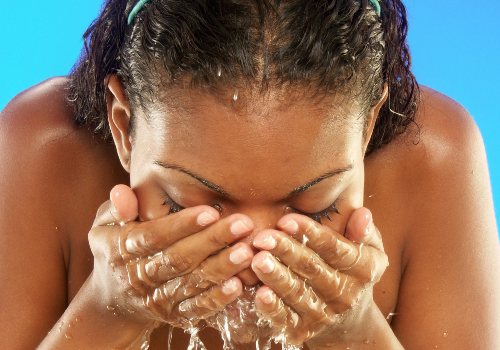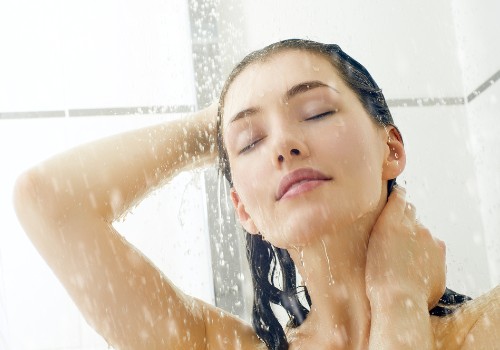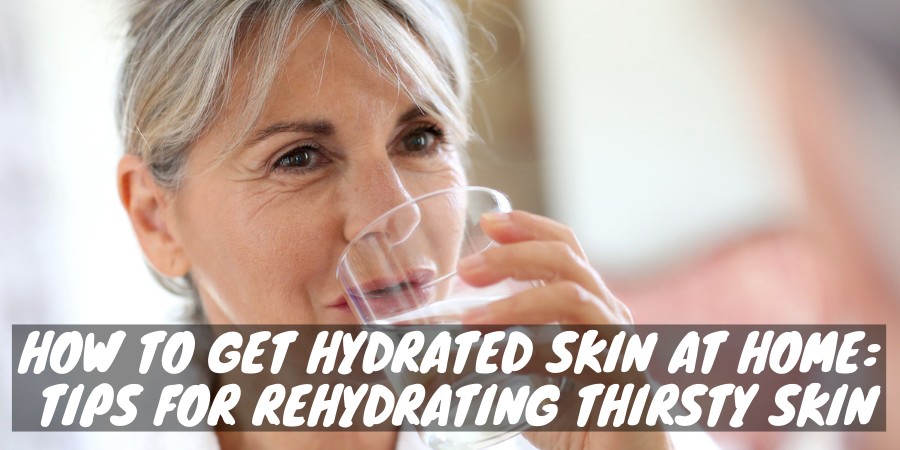Our bodies need water to function, and our skin is no exception to that rule.
Dehydrated skin looks and feels unhealthy, and it’s more prone to damage from the environment. That’s why keeping it hydrated is so important, both in the short term and in the long term.
We’ve got everything you need to know about skin hydration and moisturization, plus nine simple tips for quenching thirsty skin and keeping it that way.
Just What Is Hydrated Skin, Anyway?

There’s more to skin health than hydration, but in order for skin to be healthy, it needs to be hydrated.
That’s because skin doesn’t function properly unless it’s got enough water in it. Without adequate water, your skin won’t be able to protect and heal itself from the damage it sustains every day.
Water is what keeps our bodies working, and it’s what keeps our skin working, too. Hydrated skin is quenched, energized and operating at full capacity, so it looks and feels amazing.
Dehydrated Skin vs. Dry Skin: Which Is Which?
When you think of hydration, you think of water. So it follows that dehydrated skin is skin that’s lacking enough water.
But wait… isn’t that what dry skin is?
As it turns out, there’s a big difference between dehydrated skin and dry skin. Dehydrated skin lacks water, while dry skin lacks sebum — the oil that’s naturally produced by your skin.
So how can you tell if your skin is dry or dehydrated? Well, the symptoms are quite different, as we’re about to see.
Symptoms of Dry Skin
Dry skin is considered a skin type — there’s not much you can do to change it for good, since it’s characterized by a lack of sebum-producing glands in your skin.
If you have dry skin, you may deal with itchy, flaky patches that seem to come and go as they please. Your skin may be red and irritated quite often, especially around your eyebrows, mouth and nostrils.
Symptoms of Dehydrated Skin
Dehydrated skin isn’t a skin type like dry skin is. Rather, dehydration is a skin condition that occurs independent of skin type — and that means that it can be treated.
Itchiness can occur with dehydrated skin, which causes people to confuse it with dry skin. But if your skin is dehydrated, you’ll also notice symptoms like puffy eyes, dark circles and bags, dry mouth, fine lines and dullness.
Hydration Vs. Moisturization: Which Approach to Take?
Many people with dehydrated skin think that their skin is dry and treat it with moisturizers intended for dry skin. But these products don’t actually rehydrate your skin.
Moisturizers create a barrier that prevents your skin from losing more moisture. But if your skin doesn’t have enough moisture to begin with, no amount of moisturization will get it back to a healthy water content — that requires hydration.
Both hydration and moisturization share the same goal: making sure there’s enough water in your skin cells.
The difference is that hydration involves getting more water into those cells, while moisturization involves making sure that water doesn’t evaporate.
Nine Simple Tips for Quenching Dehydrated Skin
1. Drink Plenty of Water Every Day
It sounds obvious, but if you don’t drink enough water, your skin is going to have a hard time staying hydrated.
Your body will distribute the little water it has to more essential systems and organs, and your skin will suffer as a result.
If you want hydrated skin, you need to make sure you drink enough water to go around. Eight glasses a day is a good start for most people, but if you sweat a lot or spend time in dry environments, you’ll need more.
2. Seek Out Skincare Products that Provide Hydration
Augmenting your skincare routine with a hydrating product can make a huge difference in your skin’s water content. By supplying water directly to the skin, hydrators instantly quench your thirstiest spots.
Hydrating products contain ingredients like aloe, hyaluronic acid, glycerin or alpha hydroxy acids, which transport water directly to your skin cells.
These ingredients are known as humectants. Some, like hyaluronic acid, are available as standalone products, while others are found as ingredients in other products like toners.
3. Break Your Habit of Taking Long, Hot Showers

A long, hot shower feels like heaven on Earth after a long day, but it’s actually terrible for your skin.
Though you don’t realize it, you sweat quite a bit while you’re taking a hot shower. Every drop of sweat you produce is a drop of water you lose, and all those drops add up fast.
What you’re left with is skin that contains even less water than it did before your shower.
Cool or lukewarm showers are much better for your skin, but if you must take a hot shower, try to keep it as short as possible. Remember: the less you sweat, the better!
4. Use a Hydrating Face Mask or Sheet Mask for an Extra Boost
Pampering yourself with a face mask is a great way to relax and practice self-care. But it’s also one of the easiest, most fun ways to rehydrate your skin — as long as you use the right mask.
Many masks that advertise themselves as hydrating don’t actually rehydrate your skin, just moisturize it. As we discussed earlier, a moisture barrier won’t make thirsty skin any less thirsty.
Always check the ingredients list to make sure you’re actually getting a hydrating mask. Look for a mask that contains hyaluronic acid, aloe or alpha hydroxy acids (like lactic acid or citric acid) to ensure optimal hydration.
5. Switch to Water-Based Skincare Products
The skincare products you use every day may be contributing to your skin’s dehydration problem.
Moisturizers in particular tend to be thick and creamy, relying on fatty acids to transport the other ingredients into your skin. That’s great for making a moisture barrier but not so great for rehydrating your skin.
Consider switching to a water-based gel moisturizer. These moisturizers eschew fatty acids for good old water, which gets absorbed into your skin along with the other ingredients.
6. Run a Humidifier in Your Most-Used Rooms
If you live in a dry area, or if you spend a lot of time in air-conditioned rooms, chances are that your skin is suffering for it.
Low humidity is one of the biggest enemies of hydration. Dry air draws the moisture out of your skin in its attempts to equalize its water content, leaving you parched.
Adding humidity to the air with a humidifier will help you keep your skin’s water content at a healthy level. If you can’t run a whole-room humidifier, consider using a mini personal humidifier that runs on USB power and humidifies your immediate area.
7. Never Skip Sunscreen
As nice as the sun feels on our skin, it’s surprisingly bad for it. Not only does the sun damage your skin cells and cause cancer, it also dries out the oils that lock moisture into your skin.
The result: sunburned skin with damaged DNA that’s also completely parched.
A quality sunscreen protects you from cancer-causing UV rays, but it also stops those rays from sapping the moisture out of your skin. Applied alongside a lightweight moisturizer, it’ll ensure that your skin stays radiant, healthy, and hydrated.
Every day, apply a broad-spectrum sunscreen with an SPF of at least 15 (30 for lighter skin) and reapply it at least every two hours. Look for sunscreens that contain aloe vera or other hydrating ingredients for a double dose of skin benefits.
8. Eat Foods with a High Water Content

Not sure if you can make yourself drink eight glasses of water every day? Don’t worry — you can supplement your water intake (and make your skin happy) by eating foods that are rich in water.
The most obvious option: fresh fruits and vegetables. These can be as much as 96% water, plus they’re packed with vitamins and minerals that strengthen your skin’s water-retention abilities.
Other water-rich foods include skim milk, cottage cheese, plain yogurt and soup.
You should still try to drink as much water as you can, as it’s the most straightforward way to get hydrated. But these foods offer a tasty way to satiate your hunger and quench your thirst at the same time.
9. Incorporate a Hydrating Eye Cream into Your Routine
Your eyes reveal a lot about you, including how hydrated you are. If your skin is dehydrated, it’ll become apparent in the form of dark undereye circles, bags, fine lines and general dullness around the eyes.
That’s because the skin around the eyes is very thin and lacks sebum glands, so it’s more likely to lose moisture and become damaged.
But you can rehydrate and renew the skin around your eyes with a hydrating eye cream.
Make sure that the eye cream you use hydrates, not just moisturizes, your skin. Look for ingredients like hyaluronic acid, EGF, ceramides or glycerin for comprehensive moisture restoration.

